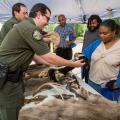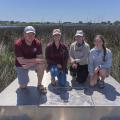Ferns for Mississippi Gardens
 Referred to as 'nature's lacework', ferns provide beauty and utility for shaded Southern gardens. These ground-hugging perennials do not offer flower or fruit, but their myriad forms, leaf sizes, leaf colors, and unique textures provide a wealth of interest for difficult garden sites.
Referred to as 'nature's lacework', ferns provide beauty and utility for shaded Southern gardens. These ground-hugging perennials do not offer flower or fruit, but their myriad forms, leaf sizes, leaf colors, and unique textures provide a wealth of interest for difficult garden sites.
The amount of variation in ferns is surprising to most gardeners, as are the many cultivars and types suitable for planting in Mississippi's climate.
How to Grow Ferns
Ferns are surprisingly easy to establish and maintain. One of their few requirements is to be planted in a shaded area, particularly one that is protected from the hot afternoon sun. Most cultivated ferns prefer a loose well-drained organic soil, but there are native cultivars well suited to poor or even wet soil types. Ferns should be planted in the spring, after all danger of frost is passed. Loosen the top four inches of soil in the area that the ferns are to be planted, and mix in well-cured compost or peat moss into the soil. The loose soil will allow fern rhizomes (an underground horizontal stem that roots at the nodes) to quickly spread and colonize the planting area. Do not disturb any existing tree roots that may be uncovered, instead simply plant the ferns around the existing roots. Cover the area with a thick layer of leaves or mulch to retain moisture. It will be important to make sure that ferns are kept moist until they are fully rooted and established. The addition of a soaker hose hidden in the mulch provides an easy method for frequent watering. Once mulched and established, ferns require little watering, fertilizing, or further care. Only during extreme droughts will additional watering usually become necessary.
Planting Compositions with Ferns
Since most ferns have very fine textured leaves, they can be effectively combined with bold, coarse-textured shade plants. Cast iron plant, bear's breech, dwarf palmetto, gingers, split-leaf philodendron, umbrella plant, and aridisa are examples of broad leaf plants that provide striking accents to ferns. Different fern types can offer a lighter green or darker green leaf color, and some even have a tinge of silver or blue. Variegated plants such as variegated vinca, ajuga, variegated Algerian ivy, hostas, ligularia, and other perennials can provide color accents for a primarily green garden. Since some ferns spread aggressively by rhizomes, such as sword fern, it is suggested to choose accompanying plants accordingly.
Ferns Types for Mississippi
Although the variety of ferns suitable for growing in Mississippi is fairly extensive, the following abbreviated list features commonly available types.
| Scientific Name | Common Name |
|---|---|
| Onoclea Sensibilis Hypolepis repens Woodwardia (Lorinseria) areolata Polystichum acrostichoides Thelypteris (Macrothelypteris) torresiana Osmunda regalis Phegopteris (Thelypteris) hexagonoptera Microlepia Strigosa Dryopteris erythrosora Diplazium esculentum Athyrium filix-femina Athyrium goeringianum (niponicum) “Pictum” Polypodim Polypodioides |
Sensitive or Bead Fern Flakelet Fern Netted Chain Fern Christmas Fern, Dagger Fern Torres or Mariana Maiden Fern Royal Fern Southern Beech Fern Asian Fern Autumn Fern Vegetable Fern Lady Fern Japanese Silver Painted Fern Resurrection Fern |
These factsheets were written by Robert F. Brzuszek, Assistant Extension Professor, The Department of Landscape Architecture, Mississippi State University.
Publications
News
An underserved community spent a day enjoying the outdoors at the Sam D. Hamilton Noxubee National Wildlife Refuge in early May as Mississippi State University Extension Service personnel hosted 20 adult residents of care homes.
Jim McAdory, MSU Extension agent in Winston County, coordinated the May 1 event with help from several other Extension agents and U.S. Fish and Wildlife Service staff. The goal was to allow this population to experience the outdoors, complete with a hot dog lunch at the end of the event.
PICAYUNE, Miss. -- School groups, nature enthusiasts and the public can enjoy two fun-filled days of exciting, hands-on learning about the environment, ecosystems, wildlife and insects at the Mississippi State University Crosby Arboretum in Picayune. BugFest offers insect-related displays, interactive exhibits, games and crafts. Biologists, naturalists, entomologists and other experts from Mississippi, Louisiana and Alabama will host booths and give presentations on butterflies, bats, caterpillars, beetles, crayfish, ladybugs, hissing cockroaches, dancing praying mantises, native and exotic arthropods and more.
Two conservation camps this summer offer students in grades six through 12 the opportunity to gain hands-on experience in wildlife science, outdoor recreation and conservation careers. Conservation Camp 2022 has a residential edition June 5-8 for rising eighth through 12th graders. The day camp edition is June 13-15 for rising sixth through eighth graders.
Success Stories
More than 80 grade-school students from Choctaw Tribal Schools visited Mississippi State University in March to participate in Choctaw Preview Day.
Robin Whitfield, who gave the child the paper, stands awestruck, watching her friend’s daughter use the flower to draw and color on the page.
Mississippi State University and partners have been awarded a grant of nearly $6.6 million from the National Fish and Wildlife Federation for shoreline restoration work on the Gulf Coast.





